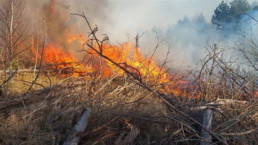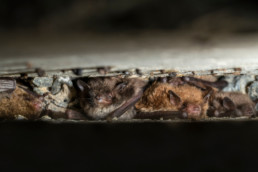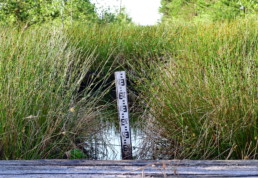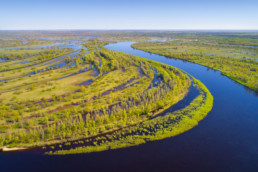Gone forever? How Polesia lost and regained its rare species
According to scientific estimates, around 1 million species of flora and fauna on Earth are currently threatened with extinction. We are witnessing a major biodiversity crisis that is, however, not the first one in the history of our planet. What makes it different is that this time, it is almost entirely due to human activity. Will rare species disappear forever, or do they still have a chance to move away from the danger line? It is hard to say for sure. But some local cases from Polesia give cause for cautious optimism.
A terrible disaster as a chance for wildlife
The accident at the Chornobyl nuclear power plant in 1986 is sometimes described as the worst man-made disaster in history. Its impact on people’s health and well-being, the economy and the environment is still enormous. A large area around the epicentre of the disaster, once densely populated and used for agriculture, was abandoned by people because of the contamination. Wildlife immediately seized the opportunity and began to reclaim the now uninhabited territory.
One of the rare species to benefit from this situation is the Greater Spotted Eagle (Clanga clanga) – a globally endangered bird that was locally extinct in what is now known as the Chornobyl Exclusion Zone. These birds depend on intact wetlands for foraging and breeding and suffer from habitat degradation and human disturbance. After the unguided rewilding of the exclusion zone had begun and former croplands had given way to mires and forests, the Greater Spotted Eagles started recolonizing this territory which is now the only place on Earth where the population of this rare eagle is growing.
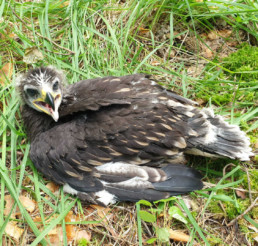
The Chornobyl Exclusion Zone is home to one more globally endangered species – the Przewalski’s horse (Equus przewalskii). Its population declined in the 1940-1950s and was considered extinct in the wild in the 1960s – only captive individuals in zoos of various countries were saved. However, as a result of successful captive breeding efforts, the number of Przewalski’s horses has increased and some were released into the wild. In 1998, 31 animals were introduced to the exclusion zone in Polesia. Within 20 years, the local population had grown to 150 animals. Indicators of genetic diversity show that this population of the Przewalski’s horse has good prospects for further growth.
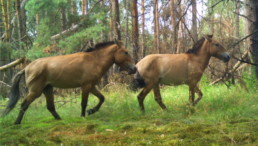
Extinct or lying low?
In the last century, the European mink (Mustela lutreola) was widespread in Polesia and in Europe as a whole, but now the species is as rare as hen’s teeth. This is because a few thousand American minks (Neogale vison) were brought to Europe in the 1930s for the fur trade. They were originally intended to be bred on farms. Later, however, some of the ‘aliens’ got into the wild. The native species could not compete with the more aggressive and strong invasive animals. The European mink was driven out of most of its historic range and became a critically endangered species. It has not been seen in Polesia for more than 20 years, and some experts believe it is extinct in the area.
In 2021, field biologists from our project set out to rediscover the European mink in Polesia. They installed 25 camera traps along rivers and drainage canals in remote areas of the Almany Mires Nature Reserve. Unfortunately, no picture of the European mink was captured. However, this does not necessarily mean that the species has disappeared from the region: the next story shows what surprises are possible when it comes to biodiversity.
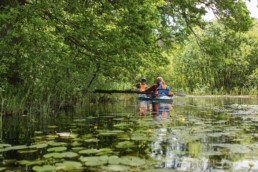
Polesia is home to at least 12 species of bats, including a real rarity – the Greater Noctule (Nyctalus lasiopterus), the largest bat in Europe. This species is rare, its range is fragmented and the smallest among the European bats. The Greater Noctule was thought to be locally extinct in Polesia. Once a male bat was shot in 1930: this was the last sighting of the species in the region until 2009, when a young male was captured by a group of researchers in the Ukrainian part of the Chornobyl Exclusion Zone. In 2015, two lactating female Greater Noctules were entrapped during a bat census in Belarusian Polesia. This proved that the rare bats were breeding in the region! In 2017, new observations of the Greater Noctule were made, and later, they were also identified in the course of acoustic monitoring as part of our project.
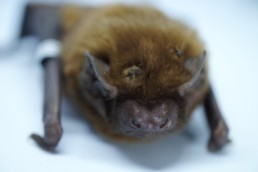
The Greater Noctule is an indicator species for the natural state of the old-growth forests. Its decline in Europe is caused by lack of suitable habitat – old-growth forests with a large number of hollow trees in a small area to ensure the successful functioning of a bat colony. In more than half of the cases, the Greater Noctule prefers to live in dead trees. This demonstrates the crucial importance of deadwood preservation for biodiversity conservation.
The cases described show that there is often a chance to reverse worrying trends and bring rare species back from the brink of extinction. And let’s use the memory of species that we will never see again in the wild as an incentive to do our best to ensure that their number grows as slowly as possible.
Safe and intact: protecting rare and typical habitats in Polesia
19. September 2025
0 Comments7 Minutes
The project “Polesia – Wilderness Without Borders” is part of the Endangered Landscapes & Seascapes Programme and is funded by Arcadia. The project is coordinated by Frankfurt Zoological Society (FZS).



